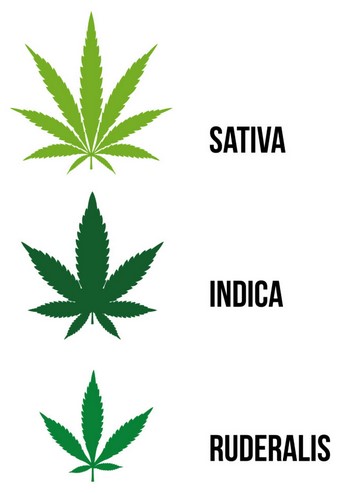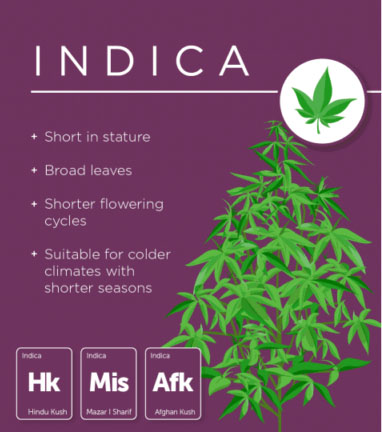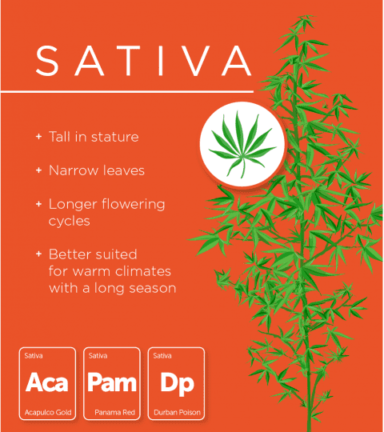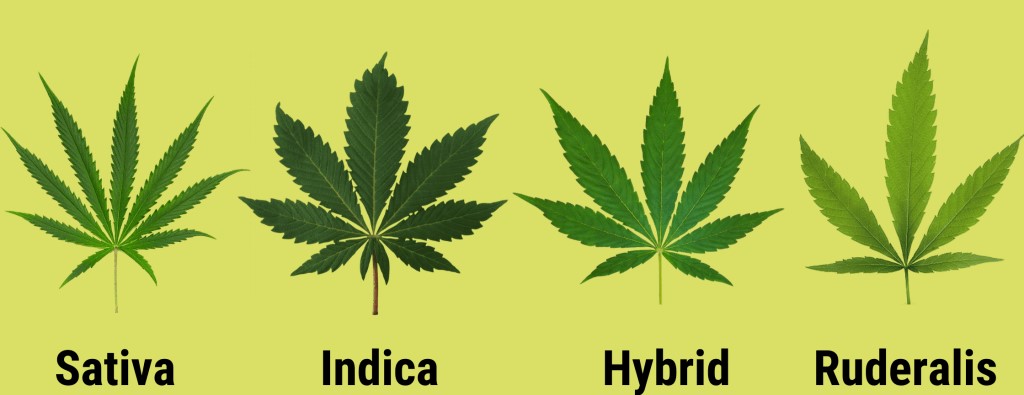
There are many differences between the anatomy of the two species: the way they are grown, how long they take to flower and more – but one of the most important differences are the chemicals they produce, and what that means for consumers of those products. Below is a more detailed explanation of the 3 which should bring it to light. Still confused? You can find more info here when we get into more details around the different occasions for cannabis use.
Keep in mind that the possible effects below do not necessarily apply to all people. Your own unique biology, expectations, and history with cannabis will dictate how you react, in addition to your surroundings and settings.
Indica vs Sativa is a personal choice and both can we used for optimal results in different circumstances. The big difference between the two types of cannabis is that they have opposite effects once consumed. So whether you are consuming cannabis for recreational or medical reasons, you will want to use the a strain that causes the desired effects. It is also worth noting that cannabis effects individuals slightly differently based on your weight, your consumption frequency, the source of the strain, and many other factors. Here are some cannabasics to get you on the right path.
Indica Cannabis

Indica plants are broadly described as being shorter marijuana plants with thick stems, broad leaves and dense buds because they tend to grow slower than sativa in the vegetation cycle.
It is thought that this is an evolutionary development that equipped the plant to thrive in the cold, harsh environment of the Himalayan Mountains on which it was originally found.
Indica flowers, stems and leaves are usually coated in thick THC trichomes to fortify the plant from the harshness of unstable winter climates.
There are many popular indica strains including but not limited to Northern Lights, OG Kush, Blueberry Kush, Bubba Kush and GDP.
This type of marijuana plant typically is shorter than its sativa counterpart, with wider leaves and dense buds. Because indica plants produce a more relaxing effect and produces a strong body high, it’s generally recommended when you need to relax, get your appetite back, get some sleep, or desire pain relief. Some would say that you should stick to using indica strains primarily at night.
Indica Effects
Primarily prized for their calming properties, indica strains are classified as having full-body effects that create a stoned feeling, inhibits sleep and is great for pain management. These effects are produced because indica strains are known to have a higher CBD percentage than sativas.
Indica strains are popular to smoke during the evening because of it sedative, sleepiness effects.
Sativa Cannabis

If you’re more interested in head highs than body, sativas will probably be more your style. Besides the “headiness” of the high, sativas are also great for alertness, uplifting and euphoric sensations, creativity, and increased energy. This type of cannabis is taller and slimmer, with long, thing leaves and “feathery” buds. Sativas are generally recommended for day time use.
Sativa cannabis is described as being a taller marijuana plant with thin, narrow leaves because of their fast vegetative growth cycle. The modern sativa leaf is commonly referred to as the physical opposite of the indica.
Because it has historically been found in warmer climates, there was never a reason for the plant to accumulate adaptive traits to manage the cold.
Popular sativa strains include Jack Herer, Sour Diesel, Blue Dream, Harlequin and Super Silver Haze.
Sativa Effects
Sativa strains are classified as having an upper, euphoric “head high” that creates an energizing effect and boost creativity because of the higher levels of THC and low levels of CBD. Users express that they tend to laugh more and have better visuals experiences. But it’s important to note that these higher levels of THC are also associated with an increase in paranoia.
Sativa is a popular strain to wake-n-bake with or smoke mid-day because of its lighter effects.
However, because of the recent legalization movements, increase in marijuana popularity, and cross-breeding explosion, recent scientific evidence has suggested that these effects are not only associated with only indica strains or sativa strains, hints why almost all marijuana today is a hybrid.
Hybrid Cannabis

Put simply, hybrids are created when an indica and sativa plant are bred together. These types commonly possess characteristics of both parent plants. The goal behind combining indicas and sativas typically can be traced back to attempting to “cross” the properties from both into a new-and-improved strain for either medical on specific ailments (lupus, cancer, etc.), or for recreational purposes.
Lastly, we look at the hybrid style cannabis plant. As the name suggests, this plant represents a hybrid combination of both plants. On the recreational front, the hybrid is prized for the fact that it combines important attributes of both important styles of strain.
However, because of how diverse the hybrid strain can be it is difficult to provide a singular description of what it looks like and how it interacts with the human mind.
Hybrid cannabis is the product of cross-breeding two different cannabis strains and two different sexes. Simply put, you’d have one male plant of one strain and one female plant.
The female marijuana plant is be pollinated by the male and the female plant produces seeds of the new strain. Voila! A hybrid has been born.
Many factors go into determining how growers select their two different strains to develop a new strain with optimal characteristics and traits including terpenes, taste, smell, and of course, the medicinal effects.
A major of the cannabis strains you smoke today are going to be hybrid, regardless, if it is labeled indica or sativa. You may find marijuana strains that are sativa dominant or indica dominant, however, cross-breeding has limited the number of pure sativa or indica strains out there.
Cannabis Hybrids Effects
Hybrid strains will give off a variety of effects because each hybrid is a cross between two different strains, meaning the effects are created by the two different parent marijuana strains.
That’s why when you’re picking out cannabis, regardless of it being indica, sativa or hybrid, you need to look at the chemical composition of the strain and its THC/CBD percentage.
Now with legalization on the rise, most cannabis is getting tested for it’s exact chemical makeup so you know how strong the bud your smoking is. Hybrids tend to have a mix between THC & CBD percentages.
Indica vs Sativa Similarities
Naturally, the similarities between the types of strains are significant. For example, all three are associated with a sense of altered perception and euphoria. All three have medical application for people suffering from a variety of different symptoms including pain, anxiety, chronic diseases, insomnia and so much more.
Conversely, all three do have a similar slew of negative side effects. These negative side effects include fatigue confusion short term memory loss and a sense of fear or anxiety. With excess use, some people experience headaches, slurred speech, and depression. These side effects are not experienced by all users and are more common in people that are underage.
Indica vs Sativa Differences
As discussed above, we already know that indica and sativas have different psychoactive and physical effects because of their cannabinoid and chemical composition. These two types of plants also have unique growing cycles, THC/CBD ratios and terpenes which separate themselves from each other.
Marijuana Growing Cycles
Both indica and sativa grow through the same vegetation cycle. If grown outside, the vegetation cycle is dictated by the amount of sunlight shining from late-spring to early summer. But when grown indoors, a grower can decide how short or long they want to make this cycle. Their flowering cycles are what make them different.
Indica Growth Cycle
Indica plants have shorter growth cycles, produce more buds for harvest and grow faster than sativas. The flowers appear most prominently near the nodes of the plant, where leaves separate from the stems on the plants, and bud in a 6-10 week cycle.
Sativa Growth Cycle
The flowering cycle is slightly different compared to the indica plant. Cannabis sativa typically has a longer flowering cycle ranging from around 10-12 weeks before it can be harvested. However, there are some sativa strains that can take 16 weeks or longer to fully flower.
THC / CBD Ratio
As mentioned above, indica buds typically have a higher CBD to THC ratio compared to sativa plants. But it’s important to note, that this isn’t always the case because of cross-genetics. For instance, Charlotte’s Web, the high CBD strain was created by the Stanley Brothers and is classified as a sativa. So you’ll never really know whether you’re smoking indica or sativa based on the cannabinoid percentage, that is only determined by the strain’s genetics.
Terpenes
Like the marijuana flower, terpenes are another by-product of the cannabis plant. Terpenes refer to the oily residue found in the glands and leaves of the plant. They exist within the same regions that produce CBD and THC oil.

They are known for being aromatic and often contribute to the unique smells and flavors found in various strains of marijuana. For example, if a strain of marijuana has a fruity or citrusy quality to its flavor, this will be thanks to the terpenes. There are over one hundred known terpenes in existence.
Terpenes are thought to be key in determining the effect a strain of marijuana give off. It is thought that terpenes may interact with other chemical elements of the plant such as cannabinoids or THC to directly shape the user experience.
The various potential outcomes of these interactions are vast and not completely understood. However, the existence of terpenes does give growers a chance to be more artisanal in their production of marijuana. It also gives consumers the opportunity to be more selective.
Labs will now test strains of marijuana to establish a detailed profile of the terpenes that are at work. In this way, they are able to better inform the potential user as to the experience they will have with the strain.
For as big and as rich as marijuana’s past has been, the future seems even brighter. Two important developments are occurring simultaneously to make this so.
On the one hand, cannabis acceptance is higher than it has ever been. Each year more and more states decriminalize or completely legalize the use of the marijuana plant. Perhaps as a direct result of this, the science surrounding marijuana has also drastically improved.
As marijuana science continues to advance and manufacturing moves over to the private sector it seems very likely that researchers will be able to do impressive new things with the cannabis plant.
One of the most important of these developments will be the isolation of various cannabinoids and chemical components of cannabis such as CBN, CBG or CBC. Selective attention to specific terpenes or THC levels can radically shape the user experience, not to mention the radical changes in the colors, look and smell that these new strains put off.
The more that researchers learn about the plant, the better able they will be to provide a tailored experience.
On the boring business side of the equation, this may mean hyper-precise patents on custom marijuana products. For consumers, it means there will be more and better options available in dispensaries all across the country.

I have been smoking for 40 years now and find the results listed above to be accurate. As a person with ADD, I have always liked Indicas because I wanted to be relaxed. If I have a busy day plan, I would enjoy a Sativa. But mixed is best. I have been a Master Grower for years, and just left the USVI, where I was one of four top growers of high grade bud. I was so excited that Canada has approved Medical Marijuana. It needs to be legal every where!
I’m agree with you, mate. Mixed is best, f@#k adderal, ritalin and other amphetamines, big pharma fears MJ as it is a replacement for all of these schedule II drugs used for pain and ADD.